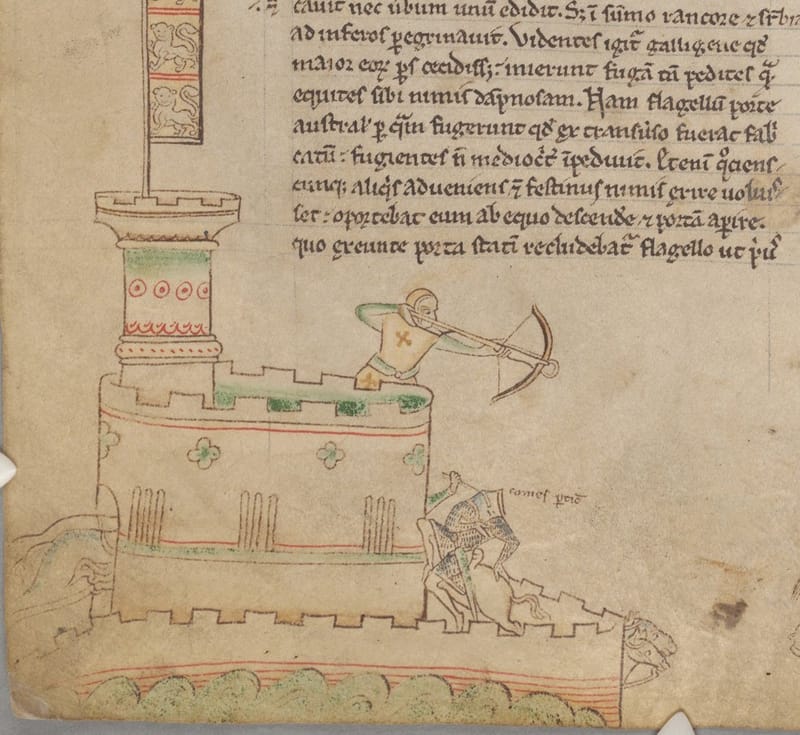The Siege of Montacute Castle

(I'm still trying to find early documentary evidence for the siege of Montacute Castle; what year did it happen and what evidence do we have that after the siege the dead were buried in Under Warren? Please email me if you can help!)
[Image; the siege of Lincoln Castle by Matthew Paris in his Chronica maiora (c.1250; MS CCC 16)]
Montacute Castle and the Normans
After 1066 William the Conqueror gave Montacute to his half-brother Robert, Count of Mortain, who constructed Montacute Castle on the sacred St Michael's Hill, “to overawe the district around”. The castle was completed by 1068 (although the Somerset Historic Environment Record 54297 and also other sites erroneously give the date as 1086). In 1068/69 (1068 according to Wikipedia and 1069 according to World History.org) there was an uprising in the West Country against the Norman overlords, and there were sieges at Montacute Castle and at Exeter Castle. The locals were defeated by Geoffrey de Montbray, the warrior Bishop of Coutances,; he had previously been accused of simony (buying his Bishopric) but had mounted a successful defense saying it had been bought for him as a gift! Writing about 50 years after the rebellion, the Benedictine monk Orderic Vitalis tells in p17-18 of Vol III of his Ecclesiastical History of England and Normandy (translated 1854 by Forester), that Geoffrey de Montbray "plumed himself upon his noble birth, and was more distinguished for military than clerical ability, better able to array armed soldiers for battle, than to teach cowled clerks in the chants of the church. He was therefore often engaged in the conflicts against the English and Danes, and when the enemy was subdued obtained vast possessions, which at his death he bequeathed to his nephew Robert, earl of Northumberland." At the siege of Montacute Castle the warring Bishop successfully led the Norman defence by bringing in troops from Salisbury, Winchester and London; local tradition says the dead were buried in Under Warren, to the south-west of St. Michael's Hill.
A. Freeman has an excellent account of the siege of Montacute Castle on pages 272 to 278 of Vol IV of his History Of Norman Conquest Of England, p272...p278 (ref Internet Archive). An excerpt translated from Orderic Vitalis' 'Ecclesiastical History' Vol II' p229 (Ed Marjorie Chibnall) gives:
1069: About this time the West Saxons of Dorset and Somerset with their neighbours attacked Montacute, but by the will of God failed to take it. For the men of Winchester, London, and Salisbury, under the leadership of Geoffrey bishop of Coutances, marched against them, killed some, captured and mutilated others, and put the rest to flight. The Welshmen and men of Chester besieged the royal stronghold at Shrewsbury, and were assisted by the native citizens, the powerful and warlike Edric the Wild, and other untameable Englishmen. 'T'he men of Devon were attacking Exeter in the same way, allied with hordes from Cornwall. This most westerly part of Britain, lying towards Ireland, is called the ‘horn of Britain', or Cornwall. The citizens of Exeter took the king's side, for they were not likely to forget the hardships they had once endured
To study the effects of the Norman invasion on the local population, the Rev. A. J. Bennett, writing for SANHS in 1879, had the elegant idea of mapping manors stated in Domesday (1086) which had decreased in value since TRE (the time of King Edward, before 1066). Regarding the Montacute region he noted a decrease in value of manors following a path from "a point a few miles west of Langport. Here it again turns southwards, and spreads out, and loses itself among a number of manors, more or less ruined, upon the western side of Montacute." (Bennett, J A, Vestiges of the Norman Conquest of Somerset, Part II, Volume 25, (1879), pp 21-28).
After the death of Robert, Count of Mortain, ownership of Montacute and its castle passed to Robert's son, William, Count of Mortain, and in 1102 he gave it to his newly-founded Cluniac priory in the village.